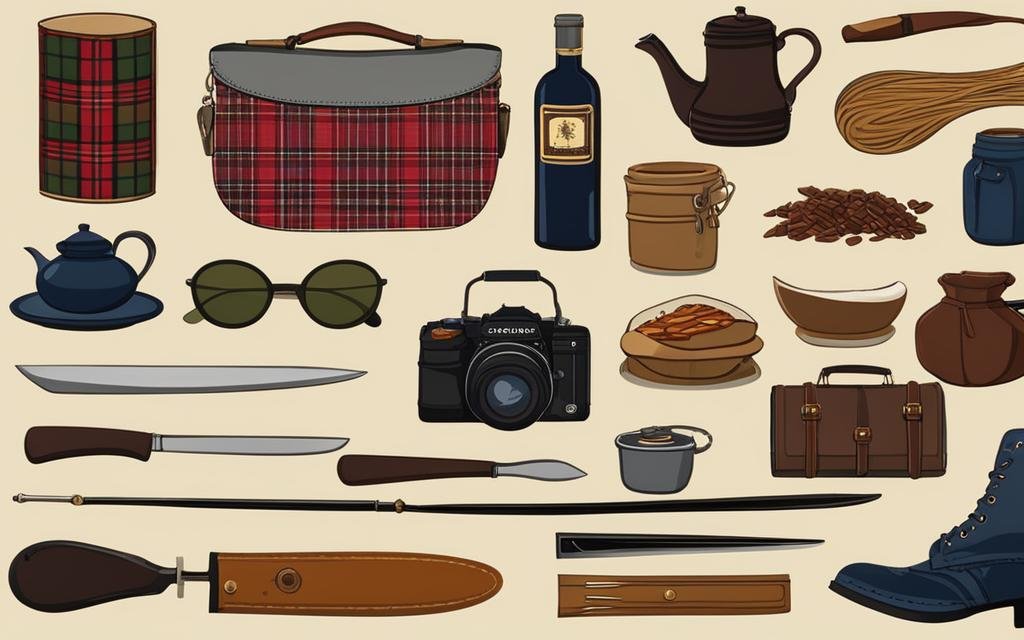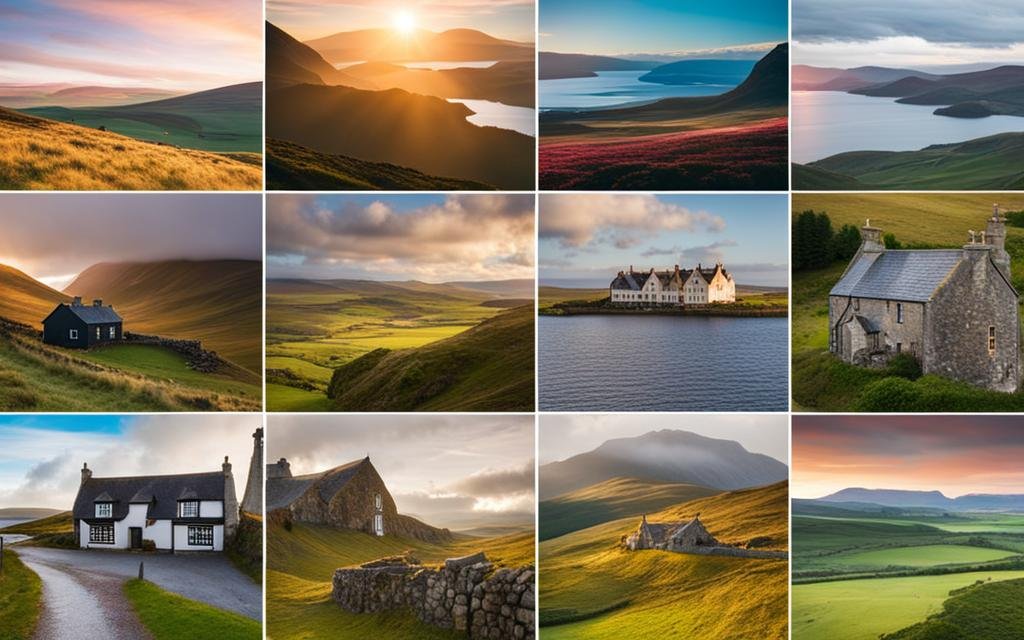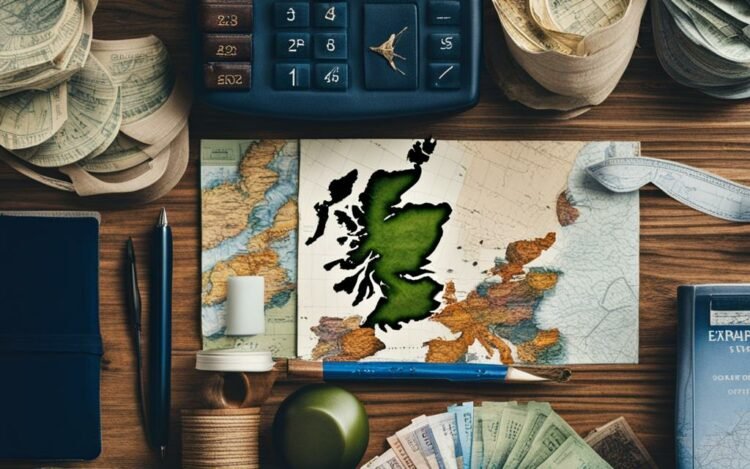Planning a trip to Scotland and curious about the cost? The expenses of a 10-day trip to Scotland can vary depending on various factors, such as the time of year and your personal travel preferences. However, based on the average prices and experiences of other travelers, we can provide you with an estimated breakdown of the costs involved. Let’s dive into the details to help you plan your budget for a memorable Scottish getaway.
Key Takeaways:
- There are several factors that can influence the overall cost of your trip to Scotland, including the time of year you plan to visit, accommodation prices, and transportation costs.
- An average daily budget for one person in Scotland can range from $42 to $81, covering meals, transportation, sightseeing fees, and other miscellaneous expenses.
- Hotel prices in Scotland average $65 to $295 per night, with vacation rentals ranging from $220 to $440 per night for the entire home.
- Additional expenses may include entrance fees for attractions like Edinburgh Castle or Urquhart Castle, which can range from $15 to $24 per person.
- Planning and budgeting accordingly will help ensure an affordable and enjoyable trip to Scotland.
Factors Affecting the Cost of a Trip to Scotland
There are several factors that can influence the overall cost of your trip to Scotland. The first factor to consider is the time of year you plan to visit. Scotland has a peak tourist season during the summer months of June, July, and August, which typically sees higher prices for accommodations, transportation, and activities. On the other hand, traveling during the off-season, such as the winter months, can often result in lower costs.
When it comes to accommodation prices, they can vary depending on factors such as location, amenities, and the time of year. It’s common to find higher rates during the peak season, while opting for the off-season might provide more affordable options. Additionally, transportation costs can vary depending on whether you choose to rent a car, use public transportation, or book organized tours.
Food expenses can also impact your overall trip budget. Scotland offers a range of dining options, from budget-friendly pubs and cafes to fine dining restaurants. Consider your preferences and budget when planning your meals.
Overall, by carefully considering these cost factors and making informed choices, you can plan a Scotland trip that fits your budget without compromising on the quality of your experience.
Image
Average Daily Expenses in Scotland
To help you plan your Scotland travel budget, it’s important to understand the average daily expenses you can expect during your trip. Based on data collected from other travelers, we have compiled an estimate of the costs involved. This will give you a rough idea of how much you should budget for each day.
Meal Costs: When it comes to dining in Scotland, you can find a range of options to suit every budget. On average, a meal at an inexpensive restaurant will cost you around $12 to $18, while a mid-range three-course meal for two people at a restaurant can cost between $50 and $80.
Transportation Expenses: Getting around Scotland is relatively easy, with various transportation options available. If you plan on using public transportation, such as buses or trains, expect to spend around $3 to $5 for a single journey within a city. If you’re exploring different cities, consider purchasing a travel pass, which can save you money on transportation costs.
Sightseeing Fees: Scotland is known for its stunning landmarks and historical sites. Entrance fees to popular attractions like Edinburgh Castle or Loch Ness can vary, ranging from $15 to $24 per person. Keep in mind that some attractions offer discounted rates for students, seniors, and children.
Miscellaneous Expenses: It’s always a good idea to set aside some extra money for miscellaneous expenses, such as Scottish souvenirs, snacks, and unexpected costs. On average, plan to budget around $10 to $15 per day for these additional expenses.
To give you a better idea of the overall daily expenses, the average budget for one person in Scotland can range from $42 to $81, including meals, transportation, sightseeing fees, and miscellaneous expenses.
Remember, these figures are just estimates, and your actual expenses may vary depending on your travel style and personal preferences. It’s always a good idea to have a buffer in your budget to account for any unforeseen expenses.
Now that you have a better understanding of the average daily expenses in Scotland, you can plan your budget accordingly. By being mindful of your spending and making informed choices, you can have a memorable and affordable trip to this beautiful country.

Accommodation Costs in Scotland
The cost of accommodation in Scotland can vary depending on factors such as location, amenities, and the time of year. Whether you prefer a luxurious getaway or a budget-friendly option, Scotland offers a range of accommodations to suit every traveler’s needs.
For those looking for hotel stays, average prices range from $65 to $295 per night, with the average nightly rate being $114. With a variety of hotels across Scotland, you can find options that fit different budgets and preferences.
If you’re seeking a unique experience, vacation rentals, such as Airbnb, present an alternative to traditional hotels. Prices for vacation rentals in Scotland can range from $220 to $440 per night for the entire home. This option allows you to immerse yourself in the local culture and enjoy the comfort of a home away from home.

Whether you choose a hotel or a vacation rental, make sure to consider factors such as location, amenities, and reviews to find the perfect accommodation that suits your preferences and budget.
Additional Expenses and Activities in Scotland
Aside from accommodation and daily expenses, there are plenty of additional activities to enjoy during your trip to Scotland. The country is known for its diverse range of outdoor adventures, historical sites, and cultural experiences. Here are some options to consider:
1. Outdoor Adventures
- Hiking the breathtaking landscapes of the Scottish Highlands.
- Exploring the stunning Isle of Skye and its iconic landscapes.
- Taking a scenic boat ride on Loch Ness, searching for the legendary Loch Ness Monster.
- Trying your hand at various water sports, such as kayaking or paddleboarding, along the picturesque Scottish coastline.
2. Historical Sites
- Visiting Edinburgh Castle, a historic fortress and one of Scotland’s most famous landmarks. Entrance fees range from $15 to $24 per person.
- Exploring the ancient ruins of Urquhart Castle, situated on the banks of Loch Ness. Entrance fees range from $15 to $24 per person.
- Discovering the fascinating history of Stirling Castle, where you can delve into Scotland’s royal past. Entrance fees range from $15 to $24 per person.
- Exploring the medieval architecture and rich history of the Royal Mile in Edinburgh.
3. Cultural Experiences
- Attending a traditional Scottish ceilidh, where you can experience traditional music, dance, and storytelling.
- Exploring the vibrant art scene in Glasgow, home to numerous galleries and museums.
- Immersing yourself in the rich Scottish culture by attending a whisky tasting or visiting a whisky distillery.
- Enjoying a traditional Scottish meal, complete with haggis, neeps, and tatties.
Keep in mind that some activities may require additional entrance fees or optional tours. It’s always a good idea to check the specific costs and availability in advance to plan your budget accordingly.
Conclusion
In conclusion, planning a trip to Scotland can be an exciting adventure that doesn’t have to break the bank. By considering factors such as the time of year, accommodation choices, and individual preferences, you can create a budget that suits your needs and allows you to explore all that Scotland has to offer.
As we discussed earlier, the cost of a 10-day trip to Scotland can vary, but with careful budgeting, it is possible to have an enjoyable experience while still traveling on a budget. Consider traveling during the off-season to take advantage of lower prices and fewer crowds. Look for budget-friendly accommodation options such as hostels or vacation rentals, and don’t forget to allocate a daily budget for meals, transportation, and sightseeing.
Remember, traveling to Scotland on a budget doesn’t mean missing out on the incredible experiences the country has to offer. Take advantage of the stunning natural landscapes, explore historical sites, and immerse yourself in the vibrant Scottish culture. With proper planning and budgeting, your trip to Scotland can be a truly unforgettable experience that fits within your financial means.
FAQ
What factors can affect the cost of a trip to Scotland?
The cost of a trip to Scotland can be influenced by factors such as the time of year, accommodation choices, transportation costs, and personal travel preferences.
What are the average daily expenses in Scotland?
On average, a daily budget for one person in Scotland can range from $42 to $81, including meals, transportation, sightseeing fees, and miscellaneous expenses.
How much does accommodation cost in Scotland?
The cost of accommodation in Scotland varies depending on factors such as location, amenities, and the time of year. On average, hotel prices range from $65 to $295 per night, with an average nightly rate of $114. Vacation rentals, such as Airbnb, can also be an option with prices ranging from $220 to $440 per night for the entire home.
Are there any additional expenses and activities in Scotland?
Yes, there may be additional costs for specific activities or attractions in Scotland. Entrance fees for popular attractions like Edinburgh Castle or Urquhart Castle, for example, can range from $15 to $24 per person.
What are some budget-friendly options for traveling to Scotland?
To travel to Scotland on a budget, consider visiting during the off-season, opting for budget accommodations, utilizing public transportation, and exploring free or low-cost activities and attractions.

